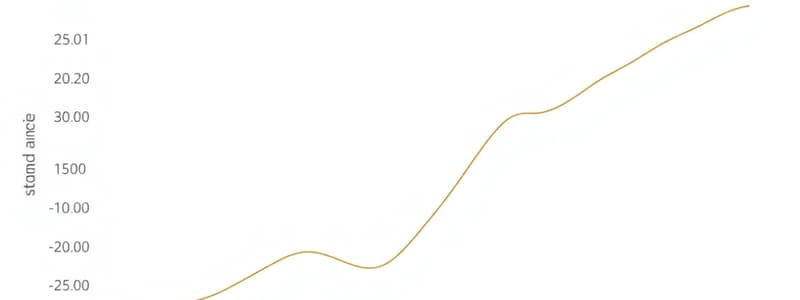Podcast
Questions and Answers
What does variability measure in a distribution?
What does variability measure in a distribution?
- The most frequent score in the distribution
- The central tendency of the scores
- The number of scores in the distribution
- The degree to which scores are spread out or clustered together (correct)
Which symbol represents the population mean?
Which symbol represents the population mean?
- s
- s²
- N
- µ (correct)
Which of the following is a measure of variability?
Which of the following is a measure of variability?
- Range (correct)
- Mean
- Median
- Mode
How is the range calculated?
How is the range calculated?
What does a larger range indicate?
What does a larger range indicate?
What is a limitation of using the range as a measure of variability?
What is a limitation of using the range as a measure of variability?
Which measure of variability is especially useful for normal distributions?
Which measure of variability is especially useful for normal distributions?
What does the Standard deviation use as a reference point?
What does the Standard deviation use as a reference point?
What does 'SD' stand for in statistics?
What does 'SD' stand for in statistics?
In the formula for standard deviation using organized data, what does 'n' represent?
In the formula for standard deviation using organized data, what does 'n' represent?
What is the relationship between standard deviation and variance?
What is the relationship between standard deviation and variance?
If the standard deviation of a dataset is 5, what is the variance?
If the standard deviation of a dataset is 5, what is the variance?
In research reports, what two descriptive statistics are commonly reported together for numerical scores?
In research reports, what two descriptive statistics are commonly reported together for numerical scores?
What is the purpose of measures of position?
What is the purpose of measures of position?
What does CM stand for in the example data table?
What does CM stand for in the example data table?
What do quartiles divide ranked data into?
What do quartiles divide ranked data into?
How many quartiles are there in a set of data?
How many quartiles are there in a set of data?
In the quartile formula, what does 'L' represent?
In the quartile formula, what does 'L' represent?
What does 'cfb' stand for in the quartile formula?
What does 'cfb' stand for in the quartile formula?
If Q1 is 5.5, approximately what percentage of scores fall below this value?
If Q1 is 5.5, approximately what percentage of scores fall below this value?
Which quartile represents the median of the data?
Which quartile represents the median of the data?
If Q3 is 11.5, approximately what percentage of the data falls below this value?
If Q3 is 11.5, approximately what percentage of the data falls below this value?
What is the first step in calculating quartiles?
What is the first step in calculating quartiles?
In the formula for quartiles, what does 'fm' represent?
In the formula for quartiles, what does 'fm' represent?
What does 'SD' stand for in the context of these formulas?
What does 'SD' stand for in the context of these formulas?
In the Raw Score Method, what does 'n' represent?
In the Raw Score Method, what does 'n' represent?
Which method calculates the standard deviation using the original scores directly?
Which method calculates the standard deviation using the original scores directly?
In the Deviation Score Method, what does 'x - x' represent?
In the Deviation Score Method, what does 'x - x' represent?
What is the first step in the Deviation Score Method?
What is the first step in the Deviation Score Method?
Why is it important to square the deviation scores $(x - x)$ in the Deviation Score Method?
Why is it important to square the deviation scores $(x - x)$ in the Deviation Score Method?
In both methods, why do we subtract 1 from 'n' in the denominator when calculating standard deviation?
In both methods, why do we subtract 1 from 'n' in the denominator when calculating standard deviation?
If the standard deviation is a small number, what does this indicate about the data?
If the standard deviation is a small number, what does this indicate about the data?
What does a percentile measure?
What does a percentile measure?
In the percentile formula, what does 'L' represent?
In the percentile formula, what does 'L' represent?
What does 'cfb' stand for in the percentile formula?
What does 'cfb' stand for in the percentile formula?
According to the example, what percentage of scores fall below the 50th percentile?
According to the example, what percentage of scores fall below the 50th percentile?
What is the value of i in the percentile formula?
What is the value of i in the percentile formula?
What is the cumulative percentage (CP) of the class interval 12-14?
What is the cumulative percentage (CP) of the class interval 12-14?
Which class interval contains the 95th percentile?
Which class interval contains the 95th percentile?
What is the relative requency (rf) of the class interval 6-8?
What is the relative requency (rf) of the class interval 6-8?
Flashcards
Variability
Variability
Measures the spread or clustering of scores in a distribution.
Mean
Mean
The average value.
Standard Deviation
Standard Deviation
A measure of how spread out numbers are.
Variance
Variance
Signup and view all the flashcards
N
N
Signup and view all the flashcards
n
n
Signup and view all the flashcards
Range
Range
Signup and view all the flashcards
Range Formula
Range Formula
Signup and view all the flashcards
SD Formula (Organized Data)
SD Formula (Organized Data)
Signup and view all the flashcards
How to Find Variance
How to Find Variance
Signup and view all the flashcards
Reporting Descriptive Statistics
Reporting Descriptive Statistics
Signup and view all the flashcards
Measure of Position
Measure of Position
Signup and view all the flashcards
Standard Deviation (reporting)
Standard Deviation (reporting)
Signup and view all the flashcards
How to Find the Total Number of Data Points (n)
How to Find the Total Number of Data Points (n)
Signup and view all the flashcards
Raw Score Method
Raw Score Method
Signup and view all the flashcards
Scores (X)
Scores (X)
Signup and view all the flashcards
Squared Score (X²)
Squared Score (X²)
Signup and view all the flashcards
ΣX (Sum of X)
ΣX (Sum of X)
Signup and view all the flashcards
ΣX² (Sum of X squared)
ΣX² (Sum of X squared)
Signup and view all the flashcards
Deviation Score Method
Deviation Score Method
Signup and view all the flashcards
Deviation Score (x - x)
Deviation Score (x - x)
Signup and view all the flashcards
Σ (x - x)²
Σ (x - x)²
Signup and view all the flashcards
What are Quartiles?
What are Quartiles?
Signup and view all the flashcards
What is 'L' in the quartile formula?
What is 'L' in the quartile formula?
Signup and view all the flashcards
What is 'i' in the quartile formula?
What is 'i' in the quartile formula?
Signup and view all the flashcards
What does 'N' represent?
What does 'N' represent?
Signup and view all the flashcards
What is 'cfb'?
What is 'cfb'?
Signup and view all the flashcards
What is 'fm'?
What is 'fm'?
Signup and view all the flashcards
What is Q1?
What is Q1?
Signup and view all the flashcards
What is Q2?
What is Q2?
Signup and view all the flashcards
What is Q3?
What is Q3?
Signup and view all the flashcards
What does (1N)/4 calculate?
What does (1N)/4 calculate?
Signup and view all the flashcards
Percentile
Percentile
Signup and view all the flashcards
L (Percentile Formula)
L (Percentile Formula)
Signup and view all the flashcards
i (Percentile Formula)
i (Percentile Formula)
Signup and view all the flashcards
kN/100 (Percentile Formula)
kN/100 (Percentile Formula)
Signup and view all the flashcards
cfb (Percentile Formula)
cfb (Percentile Formula)
Signup and view all the flashcards
fm (Percentile Formula)
fm (Percentile Formula)
Signup and view all the flashcards
P15
P15
Signup and view all the flashcards
P50
P50
Signup and view all the flashcards
P95
P95
Signup and view all the flashcards
∑f
∑f
Signup and view all the flashcards
Study Notes
- Variability measures the degree to which scores in a distribution are spread out or clustered.
Symbols for Describing Values
- Population Standard Deviation: σ
- Population Variance: σ²
- Population Mean: μ
- Total Population Observations: N
- Sample Standard Deviation: s
- Sample Variance: s²
- Sample Mean: x̄
- Total Sample Observations: n
Range
- The range is the distance from the largest to the smallest score in a distribution.
- A larger range indicates more spread-out data; a smaller range indicates more clustered data.
- The range is determined only by the two extreme values, ignoring other scores.
- Range Calculation: Highest value – Lowest Value
Standard Deviation
- Standard deviation is useful when the distribution is normal ("bell-shaped") or approximately normal.
- Standard deviation affects the shape of the "bell curve".
- Standard deviation uses the mean as a reference point.
- It describes whether scores are clustered closely around the mean or widely scattered.
Raw Score Method Formula for Standard Deviation
- SD = √[ΣX² - (ΣX)² / n] / (n-1)
Deviation Score Method Formula for Standard Deviation
- SD = √[Σ(Χ− X̄)²] / (n-1)
Organized Data Formula for Standard Deviation
- SD = √[n (fX²) – (ΣfX)²] / [n(n-1)]
Variance
- Variance is the square of the standard deviation, representing the average squared distance from the mean.
Reporting Standard Deviation
- Researchers often provide descriptive information for both central tendency and variability.
- Common descriptive statistics for numerical scores include the mean (central tendency) and standard deviation (variability).
Measures of Position
- Measures of position describe a data value's position relative to the rest of the data.
Quartiles
- Quartiles divide ranked data into quarters.
- Each data set has three quartiles.
Quartile Formula
- Qi = L + i[(iN / 4) - cfb] / fm
- L = lower boundary of interval containing the ith quartile
- i = class size
- F = frequency of the interval containing the ith quartile
- N = total number of observations
- fm = the cumulative frequency of the ith quartile
- cfb = cumulative frequency of the class before the Qi class
Percentiles
- Percentiles divide the distribution into 100 equal parts.
- Percentiles indicates the value on the measurement scale below which a specified percentage of scores fall.
Percentile Formula
- Pᵢ = L + i[(iN / 100) - cfb] / fm
- L = lower boundary of interval containing the ith percentile
- i = class size
- F = frequency of the interval containing the ith percentile
- N = total number of observations
- fm = the cumulative frequency leading up to the interval that contains the ith percentile
- cfb = cumulative frequency of the class before the Pᵢ class
Studying That Suits You
Use AI to generate personalized quizzes and flashcards to suit your learning preferences.



